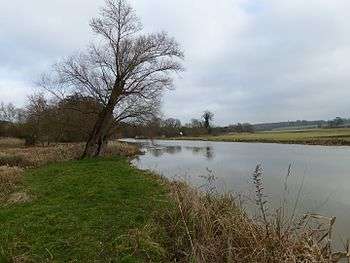List of Sites of Special Scientific Interest in Northamptonshire
Northamptonshire is a county in the East Midlands of England.[1] It has an area of 236,700 hectares (914 sq mi)[2] and a population estimated in mid-2016 at 733,000.[3] It is bordered by Warwickshire, Leicestershire, Cambridgeshire, Bedfordshire, Buckinghamshire, Oxfordshire and Lincolnshire. It is governed by Northamptonshire County Council and seven district and borough councils, Corby, Daventry, East Northamptonshire, Kettering, Northampton, South Northamptonshire and Wellingborough.[1] The county flower is the cowslip.[4]
A ridge of low Jurassic hills runs through the county, separating the basins of the Welland and Nene rivers. The county has good communications as it is crossed by two main railway lines and the M1 motorway, and it has many small industrial centres rather than large conurbations. The main architectural feature is its country houses and mansions.[5]
In England, Sites of Special Scientific Interest (SSSIs) are designated by Natural England, which is responsible for protecting England's natural environment. Designation as an SSSI gives legal protection to the most important wildlife and geological sites.[6] As of July 2017, there are 57 sites designated in Northamptonshire,[7] 48 for their biological interest and 9 for their geological interest. Eight are Geological Conservation Review sites, four are Nature Conservation Review sites, and fourteen are managed by the Wildlife Trust for Bedfordshire, Cambridgeshire and Northamptonshire. The largest is Upper Nene Valley Gravel Pits, which is a Ramsar internationally important wetland site[8] and a Special Protection Area under the European Union Directive on the Conservation of Wild Birds.[9] The smallest is Irchester Old Lodge Pit, which is described in the Geological Conservation Review as a Middle Jurassic site of national importance.[10]
Key
Interest
Public access
|
Other classifications
|
Sites
| Site name | Photograph | B | G | Area[lower-alpha 1] | Public access |
Location[lower-alpha 1] | Other classifications |
Map[lower-alpha 2] | Citation[lower-alpha 3] | Description |
|---|---|---|---|---|---|---|---|---|---|---|
| Alder Wood and Meadow |  |
13.2 hectares (33 acres)[11] |
YES | Corby 52°27′11″N 0°46′08″W / 52.453°N 0.769°W SP 837 846 [11] |
Map | Citation | This semi-natural ancient broadleaved wood is a surviving fragment of the Royal Forest of Rockingham. It is mainly ash, and the ground flora on base rich soil includes tufted hair-grass, dog's mercury and enchanter's nightshade. The meadow is agriculturally unimproved, and it has surviving medieval ridge and furrow.[12] | |||
| Aldwincle Marsh |  |
2.0 hectares (4.9 acres)[13] |
NO | Aldwincle 52°24′58″N 0°31′30″W / 52.416°N 0.525°W TL 004 807 [13] |
Map | Citation | This marsh and fen on shallow peat is formed by seepage from the boundary between clay and limestone. Plants in wet areas include blunt-flowered rush, marsh pennywort, wild angelica and Menyanthes trifoliata, a rare species of bogbean. Drier areas have grasses and herbs which attract butterflies and dragonflies. The site includes a stretch of Harpers Brook.[14] | |||
| Ashton Wold | 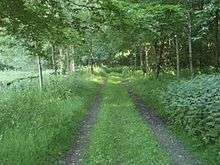 |
54.0 hectares (133 acres)[15] |
YES | Oundle 52°28′30″N 0°23′38″W / 52.475°N 0.394°W TL 091 875 [15] |
RHPG[16] | Map | Citation | Ashton Wold was owned by Charles Rothschild, the founder of The Wildlife Trusts. It is ancient secondary woodland with mature oak, ash and birch trees. The thick shrub layer includes hawthorn and buckthorn.[17] | ||
| Badby Wood |  |
47.2 hectares (117 acres)[18] |
YES | Badby 52°13′12″N 1°10′37″W / 52.220°N 1.177°W SP 563 582 [18] |
Map | Citation | This is ancient semi-natural woodland on acidic soils, and it has been forested for over 700 years. It is mainly pedunculate oak, with varied ground flora including creeping soft-grass, wood anemone, yellow archangel and bluebell. A small marsh has very diverse herbs.[19] | |||
| Badsaddle, Withmale Park and Bush Walk Woods | 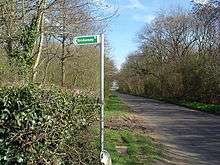 |
25.2 hectares (62 acres)[20] |
YES | Wellingborough 52°20′24″N 0°46′44″W / 52.340°N 0.779°W SP 832 720[20] |
Map | Citation | This is ancient coppice woodland with oak and ash on wet calcareous soils. Ground flora include herb paris, goldilocks buttercup and four species of orchid.[21] | |||
| Banhaw, Spring and Blackthorn's Woods | 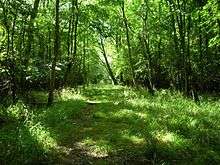 |
123.4 hectares (305 acres)[22] |
PP | Corby 52°28′48″N 0°34′16″W / 52.480°N 0.571°W SP 971 878[22] |
Map | Citation | These woods are one of the largest remnants of the ancient Royal Forest of Rockingham. They are mainly ash and pedunculate oak on wet calcareous clay soils. The ground flora is diverse, and there are grasses such as tufted hair-grass, rough meadow-grass and wood melick.[23] | |||
| Birch Spinney and Mawsley Marsh |  |
12.3 hectares (30 acres)[24] |
NO | Broughton 52°22′55″N 0°48′43″W / 52.382°N 0.812°W SP 809 766 [24] |
Map | Citation | Birch Spinney is a rare type of ash-maple woodland partly on peat. Mawsley Marsh is described by Natural England as "one of the finest remaining Northamptonshire marshes", with flora including blunt-flowered rush, jinted rush and water horsetail. There is also a stretch of a dismantled railway line.[25] | |||
| Blisworth Rectory Farm Quarry | 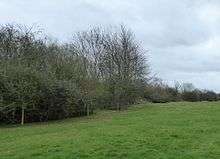 |
1.0 hectare (2.5 acres)[26] |
NO | Blisworth 52°10′16″N 0°57′14″W / 52.171°N 0.954°W SP 716 530 [26] |
GCR[27] | Map | Citation | This site exposes White Limestone dating to the Middle Jurassic Bathonian stage, around 165 million years ago. Common fossils are brachiopods, corals and gastropods, and there are also nautiloids and vertebrate teeth.[28] | ||
| Bosworth Mill Meadow |  |
5.7 hectares (14 acres)[29] |
YES | Welford 52°26′06″N 1°04′37″W / 52.435°N 1.077°W SP 628 822 [29] |
Map | Citation | This hay meadow is traditionally managed. The main flora are crested dog's-tail and common knapweed, with meadow foxtail and great burnet in wet areas. Springs produce seepages which are rich in mosses and sedges. Dry upper slopes are species poor.[30] | |||
| Bozeat Meadow |  |
2.6 hectares (6.4 acres)[31] |
NO | Bozeat 52°13′19″N 0°40′55″W / 52.222°N 0.682°W SP 901 590 [31] |
Map | Citation | This is unimproved grassland on well drained clay and loam soils. It has medieval ridge and furrow and diverse flora, including crested dog's-tail, downy oat-grass, quaking grass and dwarf thistle. There are also mature hedgerows and a spring.[32] | |||
| Bucknell Wood Meadows |  |
9.2 hectares (23 acres)[33] |
YES | Silverstone 52°05′56″N 1°03′54″W / 52.099°N 1.065°W SP 641 449[33] |
Map | Citation | This site consists of agriculturally unimproved fields on seasonally waterlogged soils. The flora is diverse with many herbs, including bird's-foot-trefoil, meadow buttercup and devil's-bit scabious. Variations in the types of flora are partly due to different soils and partly to previous management practices.[34] | |||
| Bugbrooke Meadows |  |
10.1 hectares (25 acres)[35] |
YES | Nether Heyford 52°13′23″N 1°01′05″W / 52.223°N 1.018°W SP 671 587 [35] |
WTBCN[36] | Map | Citation | These meadows on the bank of the River Nene which have not been treated with fertilisers, and they often flood in winter. They are probably unique in the county, and they have very diverse damp grassland flora such as jointed rush and greater pond sedge. There are ancient hedges which are important both historically and as a habitat for wildlife.[37] | ||
| Bulwick Meadows |  |
1.2 hectares (3.0 acres)[38] |
PP | Bulwick 52°32′20″N 0°35′02″W / 52.539°N 0.584°W SP 961 943 [38] |
Map | Citation | These marshy meadows are in the flood plain of the Willow Brook. There are diverse wetland flora, including rare species, and it is the only known locality in the county for the flat-sedge blysmus compressus and common bistort. It is also one of the very few sites in the county where snipe breed.[39] | |||
| Calender Meadows |  |
3.1 hectares (7.7 acres)[40] |
NO | Guilsborough 52°22′05″N 0°59′42″W / 52.368°N 0.995°W SP 685 749[40] |
Map | Citation | This is described by Natural England as "a nationally important site for its lowland unimproved neutral grassland". It has a wide variety of native herbs and grasses. There are herbs such as lady's bedstraw, meadow vetchling and common bird's-foot trefoil, and grasses include red fescue, sweet vernal-grass and false oat-grass.[41] | |||
| Collyweston Great Wood and Easton Hornstocks |  |
151.5 hectares (374 acres)[42] |
NO | Easton on the Hill 52°35′38″N 0°30′25″W / 52.594°N 0.507°W TF 012 006[42] |
NCR,[43] NNR[44] | Map | Citation | These woods have ash, lime and sessile oak, together with wild service-trees, which is an indicator of ancient woodland. The ground flora is very rich, including locally unusual plants such as lily-of-the-valley, wood spurge, great wood-rush, violet helleborine and columbine.[45] | ||
| Collyweston Quarries |  |
6.6 hectares (16 acres)[46] |
YES | Easton on the Hill 52°37′23″N 0°31′08″W / 52.623°N 0.519°W TF 003 038 [46] |
WTBCN[47] | Map | Citation | This former limestone quarry is now rough grassland on Jurassic limestone. The flora is diverse, and more than a hundred flowering plants have been recorded, including wild thyme, dropwort, dyer's greenweed and clustered bellflower. There is a substantial butterfly population.[48] | ||
| Collyweston Slate Mine |  |
0.9 hectares (2.2 acres)[49] |
NO | Easton on the Hill 52°36′58″N 0°31′26″W / 52.616°N 0.524°W TF 000 030 [49] |
GCR[50] | Map | Citation | This slate mine was operated until 1963, quarrying Collyweston slate, which dates to the Jurassic. The shaft exposes a section described by Natural England as "stratigraphically important", and it is the type locality for the slate.[51] | ||
| Coombe Hill Hollow |  |
4.3 hectares (11 acres)[52] |
NO | Welford 52°26′46″N 1°00′11″W / 52.446°N 1.003°W SP 678 835[52] |
Map | Citation | This steep narrow valley has neutral grassland which has never been subject to fertilisers or herbicides, and it has diverse flora. Grasses include brown bent, red fescue, Yorkshire fog and crested dog's-tail. Lime-rich areas have harebell and mouse-ear hawkweed, and there are locally important butterfly populations.[53] | |||
| Cowthick Quarry |  |
1.4 hectares (3.5 acres)[54] |
NO | Corby 52°28′55″N 0°38′20″W / 52.482°N 0.639°W SP 925 879[54] |
Map | Citation | This site exposes Middle Jurassic rocks dating to 174 to 163 million years ago, and in the view of Natural England it has "the best and most instructive sections" of the period in the Midlands. A fault during the Pleistocene has caused the juxtaposition of six Jurassic formations.[55] | |||
| Cranford St John |  |
2.8 hectares (6.9 acres)[56] |
NO | Kettering 52°22′41″N 0°38′42″W / 52.378°N 0.645°W SP 923 764 [56] |
GCR[57] | Map | Citation | This former quarry exposes rocks from the Rutland Formation and up to nearly the top of the White Limestone Formation, dating to the Middle Jurassic Bathonian stage, 169 to 166 million years ago. The site is the type section for a freshwater clay bed which is thought to result from a widespread storm deposit.[58] | ||
| Dungee Corner Meadow |  |
5.1 hectares (13 acres)[59] |
NO | Bozeat 52°13′52″N 0°38′35″W / 52.231°N 0.643°W SP 927 600 [59] |
Map | Citation | This well drained hay meadow on boulder clay is traditionally managed, and no artificial fertilisers or herbicides have been used, so it has a diverse flora. More than twenty grass species have been recorded, including sweet vernal, Yorkshire fog, sheep's fescue, quaking grass and crested dog's-tail. There is also a population of the locally rare green-winged orchid.[60] | |||
| Everdon Stubbs |  |
29.5 hectares (73 acres)[61] |
YES | Farthingstone 52°12′18″N 1°06′54″W / 52.205°N 1.115°W SP 605 566[61] |
WT[62] | Map | Citation | This woodland site has areas of acidic free-draining soil, and other damper areas. It is described by Natural England as an important site for fungi, and there is a diverse range of breeding birds. There are locally uncommon plants such as wild daffodil, orpine and bitter vetch.[63] | ||
| Finedon Top Lodge Quarry | 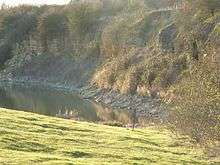 |
0.9 hectares (2.2 acres)[64] |
FP | Finedon 52°19′12″N 0°38′31″W / 52.320°N 0.642°W SP 926 699 [64] |
GCR[65] | Map | Citation | This site shows a complete section dating to the Rutland Formation of the Bathonian stage of the Middle Jurassic, 168 to 166 million years ago. It is the type section for the Wellingborough Member, and contains fossils of oysters and Rhynchonellida.[66] | ||
| Geddington Chase |  |
39.1 hectares (97 acres)[67] |
NO | Corby 52°27′11″N 0°40′12″W / 52.453°N 0.670°W SP 904 847 [67] |
Map | Citation | Geddington Chase is a surviving fragment of the medieval Royal Forest of Rockingham. Most of the Chase is commercially managed, and the SSSI is an area of semi-natural wet ash/maple woodland on Midland boulder clay. The ground flora is diverse, with plants including bluebell, dog's mercury, tufted hair-grass, and a few wild daffodils.[68] | |||
| Glapthorn Cow Pasture |  |
28.2 hectares (70 acres)[69] |
YES | Oundle 52°30′14″N 0°31′30″W / 52.504°N 0.525°W TL 002 905[69] |
WTBCN[70] | Map | Citation | This site has ash and maple woodland, and dense blackthorn scrub. It is described by Natural England as one of the most important sites in Britain for the black hairstreak butterfly, which requires a habitat of prunus species such as blackthorn. The scrub also provides nesting sites for nightingales.[71] | ||
| Hardwick Lodge Meadow |  |
10.0 hectares (25 acres)[72] |
YES | Wellingborough 52°19′26″N 0°46′37″W / 52.324°N 0.777°W SP 834 702 [72] |
Map | Citation | This unimproved grassland on boulder clay has a rich variety of flora, including many rare in the county. Crested hair-grass and salad burnet are found in drier parts, and a marshy area next to a stream has common spotted-orchid and the only population in Northamptonshire of heath spotted-orchid.[73] | |||
| Helmdon Disused Railway | _-_geograph.org.uk_-_428884.jpg) |
16.6 hectares (41 acres)[74] |
YES | Brackley 52°04′01″N 1°08′35″W / 52.067°N 1.143°W SP 588 412 [74] |
Map | Citation | This is Jurassic grassland, and it also has limestone spoil heaps have a very diverse floral community. Butterfies include the nationally scarce wood white and five nationally declining species. It is the only location in the county for the small blue butterfly.[75] | |||
| High Wood and Meadow | 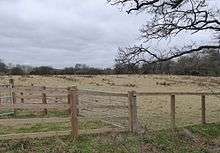 |
16.5 hectares (41 acres)[76] |
YES | Daventry 52°11′17″N 1°08′10″W / 52.188°N 1.136°W SP 591 547 [76] |
WTBCN[77] | Map | Citation | The wood is ancient and semi-natural on acid soils. It has diverse ground flora, including yellow pimpernel, hairy wood-rush and broad-leaved helleborine. The meadow is acid grassland of a type which is now uncommon, and there are also areas of neutral grassland and marsh on silty peat. There are many ant hills of the yellow meadow ant.[78] | ||
| Irchester Old Lodge Pit | 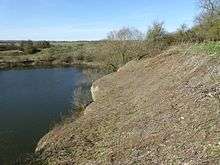 |
0.4 hectares (0.99 acres)[79] |
NO | Irchester 52°16′30″N 0°39′40″W / 52.275°N 0.661°W SP 914 649[79] |
GCR[80] | Map | Citation | This is described by Natural England as "a key Middle Jurassic locality important for the information it yields on both Bathonian environments and stratigraphy". It exposes White Limestone which has many fossils, especially molluscs.[10] | ||
| King's Cliffe Banks |  |
7.7 hectares (19 acres)[81] |
YES | King's Cliffe 52°33′50″N 0°30′18″W / 52.564°N 0.505°W TL 014 972 [81] |
Map | Citation |
This former quarry has undulating calcareous grassland which is grazed by rabbits and cattle. It has a rich variety of flora, including sheep's fescue, dwarf thistle, mouse-ear hawkweed, wild thyme and common rock-rose. There are many bryophytes and lichens.[82] | |||
| Mantles Heath | 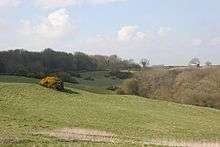 |
13.7 hectares (34 acres)[83] |
YES | Daventry 52°11′31″N 1°07′37″W / 52.192°N 1.127°W SP 597 552 [83] |
Map | Citation | Most of this woodland site is on acid soil, but the western part is on calcareous and poorly drained clay, and has a diverse flora. Locally uncommon plants include wood vetch, opposite-leaved golden-saxifrage and slender St John’s wort.[84] | |||
| Mill Crook | 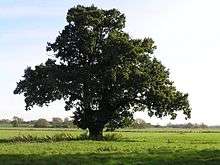 |
5.9 hectares (15 acres)[85] |
YES | Towcester 52°06′36″N 0°52′19″W / 52.110°N 0.872°W SP 773 463 [85] |
WTBCN[86] | Map | Citation | Signs of medieval ridge and furrow still survive on this traditionally managed hay meadow on the bank of the River Tove. It has diverse flora, with grasses such as meadow foxtail and sweet vernal-grass, and herbs including great burnet and ribwort plantain.[86][87] | ||
| Old Sulehay Forest | 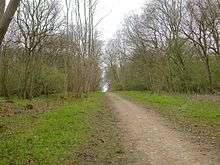 |
34.8 hectares (86 acres)[88] |
YES | King's Cliffe 52°34′26″N 0°26′02″W / 52.574°N 0.434°W TL 062 985 [88] |
WTBCN[89] | Map | Citation | This ancient forest has a number of different soil conditions and coppice types, and the ground flora is diverse. Abundant herbs include dog’s mercury, bracken, bramble, ramsons, wood anemone and bluebells.[90] | ||
| Pipewell Woods |  |
85.3 hectares (211 acres)[91] |
YES | Corby 52°28′01″N 0°46′30″W / 52.467°N 0.775°W SP 833 861 [91] |
NCR[92] | Map | Citation | The woods are an example of wet ash-maple woodland, some parts in a nationally rare form. It has diverse flora including the locally rare giant bellflower, herb paris and wood speedwell. Open grassy areas provide additional habitats for birds and insects.[93] | ||
| Pitsford Reservoir |  |
413.1 hectares (1,021 acres)[94] |
YES | Brixworth 52°19′26″N 0°52′01″W / 52.324°N 0.867°W SP 773 701[94] |
WTBCN[95] | Map | Citation | This is the largest body of water in the county, and is used by wintering wildfowl, including the northern shoveler in nationally important numbers. Over 60 species of birds breed on the site, such as the great crested grebe, little grebe, teal, kingfisher and reed warbler.[95][96] | ||
| Plumpton Pasture |  |
3.6 hectares (8.9 acres)[97] |
NO | Towcester 52°07′41″N 1°07′59″W / 52.128°N 1.133°W SP 594 480 [97] |
Map | Citation | There are medieval ridge and furrows on this unimproved meadow on clay. The drier ridge tops have many herbs, while the damp furrows are dominated by creeping bent and Yorkshire fog grasses. There are also mature hedges and a small pond.[98] | |||
| Racecourse Farm Fields |  |
5.0 hectares (12 acres)[99] |
NO | Easton on the Hill 52°37′34″N 0°29′53″W / 52.626°N 0.498°W TF 017 042[99] |
Map | Citation | This former quarry is grassland on Jurassic limestone. The flora is diverse, with over thirty flowering plant species in each square metre. There are several locally rare plants, such as dodder, autumn gentian, clustered bellflower and small scabious. The sward is kept short by grazing by sheep and cattle.[100] | |||
| Ramsden Corner Plantation | 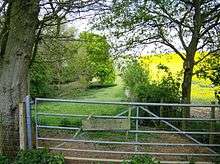 |
3.2 hectares (7.9 acres)[101] |
YES | Northampton 52°12′11″N 1°05′20″W / 52.203°N 1.089°W SP 623 564[101] |
WTBCN[102] | Map | Citation | A stream runs through this valley site, which also has acidic grassland, woodland and scrub on clay and sand. Plants such as wood millet, wood-sorrel and wood vetch are indicators of ancient woodland. Opposite-leaved golden-saxifrage is found in wet flushes.[103] | ||
| River Ise and Meadows |  |
13.5 hectares (33 acres)[104] |
PP | Geddington 52°26′17″N 0°43′08″W / 52.438°N 0.719°W SP 871 830[104] |
WTBCN[105] | Map | Citation | The river is described by Natural England as "the best example in the county of a lowland river on clay, fed by base-rich water". The banks have tall fen, woodland and grassland, and there is also a species rich flood meadow. The river has many bends and loops, with silty pools and gravel shoals. The invertebrates are diverse, and there is a population of the nationally declining freshawter crayfish Austropotamobius pallipes.[106] | ||
| Roade Cutting | 15.2 hectares (38 acres)[107] |
NO | Roade 52°09′58″N 0°54′22″W / 52.166°N 0.906°W SP 749 525 [107] |
GCR[108] | Map | Citation | The cutting exposes rocks dating to the Middle Jurassic Bathonian stage, between 168.3 and 167.1 million years ago. It is described by Natural England as important for reconstructing the environment of deposition during the period, and correlating the White Limestone Formation in Oxfordshire with that of the East Midlands.[109] | |||
| Salcey Forest | 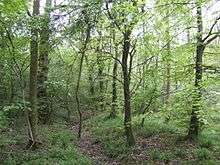 |
159.6 hectares (394 acres)[110] |
YES | Hartwell 52°09′07″N 0°49′05″W / 52.152°N 0.818°W SP 809 510[110] |
Map | Citation | This large forest has many mature oak trees. The diverse ground flora includes bluebells, false brome, pendulous sedge and enchanter's nightshade. There are many breeding birds and nationally notable moth species.[111] | |||
| Short Wood |  |
25.3 hectares (63 acres)[112] |
YES | Oundle 52°30′40″N 0°30′18″W / 52.511°N 0.505°W TL 015 913 [112] |
WTBCN[113] | Map | Citation | Short Wood is a small remnant of the medieval royal hunting Rockingham Forest. It is ancient semi-natural woodland with the dominant trees being ash and pedunculate oak. Flora include several local rarities such as wood speedwell, bird's nest orchid and greater butterfly orchid.[114] | ||
| Southfield Farm Marsh |  |
8.6 hectares (21 acres)[115] |
PP | Kettering 52°22′26″N 0°42′07″W / 52.374°N 0.702°W SP 884 758 [115] |
WTBCN[116] | Map | Citation | This wetland site has tall plants such as lesser pond-sedge and slender tufted-sedge, which provides cover for reed buntings and sedge warblers. Mammals include otters, and there are birds such as red kites and buzzards. Purple loosestrife is found in grassland areas.[116] | ||
| Stoke and Bowd Lane Woods |  |
36.4 hectares (90 acres)[117] |
PP | Corby 52°28′12″N 0°49′12″W / 52.470°N 0.820°W SP 802 864 [117] |
WTBCN[118] | Map | Citation | These ancient semi-natural woods were formerly part of the medieval Royal Forest of Rockingham. The main tree species is pedunculate oak, with other species such as ash and birch. Ground flora include herb paris, wood sorrel, yellow archangel, early-purple orchid and greater butterfly-orchid.[119] | ||
| Sudborough Green Lodge Meadows | 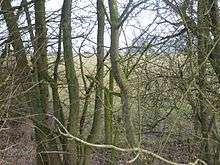 |
13.6 hectares (34 acres)[120] |
NO | Sudborough 52°26′49″N 0°34′23″W / 52.447°N 0.573°W SP 970 841[120] |
NCR[121] | Map | Citation | This site consists of two hay meadows, one of which is agriculturally unimproved and has large areas of medieval ridge and furrow. An experiment in trying to create attractive grasslands in the other field has potential for scientific research. Ponds, scrub, willow trees, hedgerows and wild pear trees add to the ecological value.[121] | ||
| Syresham Marshy Meadows |  |
17.8 hectares (44 acres)[122] |
PP | Silverstone 52°04′41″N 1°04′01″W / 52.078°N 1.067°W SP 640 425[122] |
Map | Citation | This site consists of two nearby areas of wetland in valleys which drain into the River Great Ouse. The northern one is a mire on shallow peat, and the southern one is agriculturally unimproved grassland and marsh on diverse soils, which has over a hundred flowering plant species.[123] | |||
| Thrapston Station Quarry | 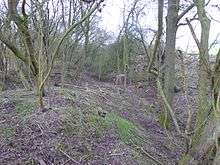 |
4.5 hectares (11 acres)[124] |
NO | Thrapston 52°23′17″N 0°31′59″W / 52.388°N 0.533°W SP 999 776[124] |
GCR[125] | Map | Citation | This site has the most important remaining Middle Jurassic Cornbrash geological section in the Midlands, and it has the only complete Blisworth Clay section. Diagnostic ammonites have helped to date the site, which has also yielded important Bryozoan fossils.[126] | ||
| Titchmarsh Meadow | 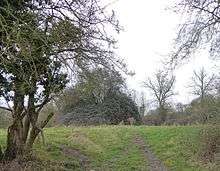 |
2.2 hectares (5.4 acres)[127] |
NO | Titchmarsh 52°24′18″N 0°29′13″W / 52.405°N 0.487°W TL 030 796 [127] |
Map | Citation | This poorly drained field has a rich variety of plant species, including greater bird’s-foot-trefoil, southern marsh-orchid and pepper saxifrage. A medieval fish pond, which has been drained, has marsh vegetation. Hedges, streams and ditches provide a valuable habitat for invertebrates and small mammals.[128] | |||
| Twywell Gullet |  |
17.1 hectares (42 acres)[129] |
PP | Kettering 52°23′17″N 0°36′50″W / 52.388°N 0.614°W SP 944 775[129] |
WTBCN[130] | Map | Citation | Twywell Gullet is a former ironstone quarry which has deep cuttings with steeply sloping banks. It has species-rich limestone grassland on the slopes and ponds and scrub in the bottoms. There are a number of uncommon ground nesting bees and wasps, and beetles include the nationally rare ruddy darter.[131] | ||
| Upper Cherwell at Trafford House |  |
18.6 hectares (46 acres)[132] |
YES | Eydon 52°08′06″N 1°13′44″W / 52.135°N 1.229°W SP 528 488 [132] |
GCR[133] | Map | Citation | This site is at the confluence of the River Cherwell and Eydon Brook. They are underfit streams, which have channels which are small for the size of their valleys. According to Natural England, the site has played an important role in the development of the theory of underfit streams. Deposits in a paleochannel could enable reconstruction of the environmental history.[134] | ||
| Upper Nene Valley Gravel Pits |  |
1,382.4 hectares (3,416 acres)[135] |
PP | Rushden 52°18′50″N 0°38′20″W / 52.314°N 0.639°W SP 928 693[135] |
LNR,[136][137] Ramsar,[8] SPA,[9] WTBCN[135][138][139] | Map | Citation | This site is described by Natural England as "a nationally important site for its breeding bird assemblage of lowland open waters and their margins". There are at least 21 breeding bird species, including mute swans, tufted ducks, little grebes, great crested grebes, little ringed plovers and redshanks.[140] | ||
| Wadenhoe Marsh and Achurch Meadow |  |
47.5 hectares (117 acres)[141] |
PP | Oundle 52°25′59″N 0°31′01″W / 52.433°N 0.517°W TL 009 826 [141] |
Map | Citation | This complex site on both sides of the River Nene has a variety of habitats and a diverse range of fauna and flora. The west of the river is alder woodland and marshy grassland. On the east there is the largest example in the county of unimproved grassland on alluvium and gravel, with over 100 flowering plant species. An oxbow in the river is a site for rare plants.[142] | |||
| Wakerley Spinney |  |
4.4 hectares (11 acres)[143] |
NO | King's Cliffe 52°34′37″N 0°34′37″W / 52.577°N 0.577°W SP 965 986[143] |
Map | Citation | This is a remnant of the ancient Royal Forest of Rockingham, and it has broadleaved woodland and semi-natural grassland. The most common trees are pedunculate oak, ash, sycamore and downy birch. Locally uncommon flowering plants include woodruff, violet helleborine and fly orchid.[144] | |||
| Weldon Park |  |
51.7 hectares (128 acres)[145] |
NO | Weldon 52°30′00″N 0°36′25″W / 52.500°N 0.607°W SP 946 900 [145] |
Map | Citation | This ancient woodland is mainly ash, maple and hazel. It has diverse flora, especially on grassland rides, and unusual plants on the wettest soils. Insects include the uncommon purple emperor butterfly.[146] | |||
| Whittlewood Forest |  |
400.1 hectares (989 acres)[147] |
PP | Silverstone 52°04′52″N 0°56′56″W / 52.081°N 0.949°W SP 721 430 [147] |
NCR[92] | Map | Citation | This is ancient semi-natural woodlands with many trees which are mature or over-mature, especially pedunculate oaks. There are also many ash trees and a scattering of silver birches and aspens. The oaks have nationally rare and nationally uncommon beetles, and there are locally rare lichens.[148] | ||
| Wollaston Meadows |  |
14.3 hectares (35 acres)[149] |
NO | Wellingborough 52°16′26″N 0°41′10″W / 52.274°N 0.686°W SP 897 648[149] |
Map | Citation | This site on the banks of the River Nene is composed of two species-rich hay fields. Flora include meadow foxtail, crested dog's-tail and red fescue. Overgrown hedges and ditches provide habitats for birds, small mammals and invertebrates.[150] | |||
| Yardley Chase |  |
357.6 hectares (884 acres)[151] |
PP | Yardley Hastings 52°10′52″N 0°45′47″W / 52.181°N 0.763°W SP 846 543 [151] |
Map | Citation | The Chase has diverse semi-natural habitats, and its value for invertebrates has been enhanced by military use of the site, which has resulted in a long absence of intensive agriculture. There is woodland and unimproved grassland, and 30 breeding butterfly species have been recorded.[152] |
See also
- List of Local Nature Reserves in Northamptonshire
- Wildlife Trust for Bedfordshire, Cambridgeshire and Northamptonshire
| Wikimedia Commons has media related to Sites of Special Scientific Interest in Northamptonshire. |
Notes
References
- 1 2 "Your Guide to the Counties of England". countiesinengland.com. Archived from the original on 10 October 2016. Retrieved 3 May 2017.
- ↑ "Standard Area Measurements (2016) for Administrative Areas in the United Kingdom". Office for National Statistics. Archived from the original on 10 April 2017. Retrieved 3 May 2017.
- ↑ "Population Estimates for UK, England and Wales, Scotland and Northern Ireland". Office for National Statistics. Retrieved 31 July 2017.
- ↑ "Plant and fungi species: Cowslip". Plantlife. Archived from the original on 2 January 2017. Retrieved 3 May 2017.
- ↑ "Northamptonshire". Encyclopædia Britannica. Archived from the original on 22 April 2016. Retrieved 3 May 2017.
- ↑ "Sites of Special Scientific Interest: Designation". Natural England. Retrieved 19 April 2016.
- 1 2 "Designated Sites View: Northamptonshire". Natural England. Retrieved 31 July 2017.
- 1 2 "Information Sheet on Ramsar Wetlands (RIS): Upper Nene Valley Gravel Pits" (PDF). Joint Nature Conservation Committee. Retrieved 19 December 2016.
- 1 2 "Special Protection Areas under the EC Birds Directive. Upper Nene Valley Gravel Pits" (PDF). Joint Nature Conservation Committee. Retrieved 19 December 2016.
- 1 2 "Irchester Old Lodge Pit citation" (PDF). Sites of Special Scientific Interest. Natural England. Retrieved 27 March 2017.
- 1 2 "Designated Sites View: Alder Wood and Meadow". Sites of Special Scientific Interest. Natural England. Retrieved 6 February 2017.
- ↑ "Alder Wood and Meadow citation" (PDF). Sites of Special Scientific Interest. Natural England. Retrieved 6 February 2017.
- 1 2 "Designated Sites View: Aldwincle Marsh". Sites of Special Scientific Interest. Natural England. Retrieved 19 February 2017.
- ↑ "Aldwincle Marsh citation" (PDF). Sites of Special Scientific Interest. Natural England. Retrieved 19 February 2017.
- 1 2 "Designated Sites View: Ashton Wold". Sites of Special Scientific Interest. Natural England. Retrieved 19 December 2016.
- ↑ "Ashton Wold". Historic England. Retrieved 18 December 2016.
- ↑ "Ashton Wold citation" (PDF). Sites of Special Scientific Interest. Natural England. Retrieved 19 December 2016.
- 1 2 "Designated Sites View: Badby Wood". Sites of Special Scientific Interest. Natural England. Retrieved 26 February 2017.
- ↑ "Badby Wood citation" (PDF). Sites of Special Scientific Interest. Natural England. Retrieved 26 February 2017.
- 1 2 "Designated Sites View: Badsaddle, Withmale Park and Bush Walk Woods". Sites of Special Scientific Interest. Natural England. Retrieved 19 December 2016.
- ↑ "Badsaddle, Withmale Park and Bush Walk Woods citation" (PDF). Sites of Special Scientific Interest. Natural England. Retrieved 19 December 2016.
- 1 2 "Designated Sites View: Banhaw, Spring and Blackthorn's Woods". Sites of Special Scientific Interest. Natural England. Retrieved 19 December 2016.
- ↑ "Banhaw, Spring and Blackthorn's Woods citation" (PDF). Sites of Special Scientific Interest. Natural England. Retrieved 19 December 2016.
- 1 2 "Designated Sites View: Birch Spinney and Mawsley Marsh". Sites of Special Scientific Interest. Natural England. Retrieved 13 March 2017.
- ↑ "Birch Spinney and Mawsley Marsh citation" (PDF). Sites of Special Scientific Interest. Natural England. Retrieved 13 March 2017.
- 1 2 "Designated Sites View: Blisworth Rectory Farm Quarry". Sites of Special Scientific Interest. Natural England. Retrieved 19 March 2017.
- ↑ "Blisworth Rectory Farm (Bathonian)". Joint Nature Conservation Committee. Retrieved 18 December 2016.
- ↑ "Blisworth Rectory Farm Quarry citation" (PDF). Sites of Special Scientific Interest. Natural England. Retrieved 19 March 2017.
- 1 2 "Designated Sites View: Bosworth Mill Meadow". Sites of Special Scientific Interest. Natural England. Retrieved 5 February 2017.
- ↑ "Bosworth Mill Meadow citation" (PDF). Sites of Special Scientific Interest. Natural England. Retrieved 5 February 2017.
- 1 2 "Designated Sites View: Bozeat Meadow". Sites of Special Scientific Interest. Natural England. Retrieved 26 March 2017.
- ↑ "Bozeat Meadow citation" (PDF). Sites of Special Scientific Interest. Natural England. Retrieved 26 March 2017.
- 1 2 "Designated Sites View: Bucknell Wood Meadows". Sites of Special Scientific Interest. Natural England. Retrieved 10 April 2017.
- ↑ "Bucknell Wood Meadows citation" (PDF). Sites of Special Scientific Interest. Natural England. Retrieved 10 April 2017.
- 1 2 "Designated Sites View: Bugbrooke Meadows". Sites of Special Scientific Interest. Natural England. Retrieved 19 March 2017.
- ↑ "Bugbrooke Meadow". Wildlife Trust for Bedfordshire, Cambridgeshire and Northamptonshire. Retrieved 19 December 2016.
- ↑ "Bugbrooke Meadows citation" (PDF). Sites of Special Scientific Interest. Natural England. Retrieved 19 March 2017.
- 1 2 "Designated Sites View: Bulwick Meadows". Sites of Special Scientific Interest. Natural England. Retrieved 2 April 2017.
- ↑ "Bulwick Meadows citation" (PDF). Sites of Special Scientific Interest. Natural England. Retrieved 2 April 2017.
- 1 2 "Designated Sites View: Calender Meadows". Sites of Special Scientific Interest. Natural England. Retrieved 13 March 2017.
- ↑ "Calender Meadows citation" (PDF). Sites of Special Scientific Interest. Natural England. Retrieved 13 March 2017.
- 1 2 "Designated Sites View: Collyweston Great Wood and Easton Hornstocks". Sites of Special Scientific Interest. Natural England. Retrieved 19 December 2016.
- ↑ Ratcliffe, A Nature Conservation Review, p. 57
- ↑ "Northamptonshire's National Nature Reserves". Natural England. Retrieved 19 December 2016.
- ↑ "Collyweston Great Wood and Easton Hornstocks citation" (PDF). Sites of Special Scientific Interest. Natural England. Retrieved 19 December 2016.
- 1 2 "Designated Sites View: Collyweston Quarries". Sites of Special Scientific Interest. Natural England. Retrieved 2 April 2017.
- ↑ "Collyweston Quarries". Wildlife Trust for Bedfordshire, Cambridgeshire and Northamptonshire. Retrieved 19 December 2016.
- ↑ "Collyweston Quarries citation" (PDF). Sites of Special Scientific Interest. Natural England. Retrieved 2 April 2017.
- 1 2 "Designated Sites View: Collyweston Slate Mine". Sites of Special Scientific Interest. Natural England. Retrieved 3 April 2017.
- ↑ "Collyweston (Aalenian - Bajocian)". Joint Nature Conservation Committee. Retrieved 18 December 2016.
- ↑ "Collyweston Slate Mine citation" (PDF). Sites of Special Scientific Interest. Natural England. Retrieved 3 April 2017.
- 1 2 "Designated Sites View: Coombe Hill Hollow". Sites of Special Scientific Interest. Natural England. Retrieved 5 February 2017.
- ↑ "Coombe Hill Hollow citation" (PDF). Sites of Special Scientific Interest. Natural England. Retrieved 5 February 2017.
- 1 2 "Designated Sites View: Cowthick Quarry". Sites of Special Scientific Interest. Natural England. Retrieved 12 February 2017.
- ↑ "Cowthick Quarry citation" (PDF). Sites of Special Scientific Interest. Natural England. Retrieved 12 February 2017.
- 1 2 "Designated Sites View: Cranford St John". Sites of Special Scientific Interest. Natural England. Retrieved 17 April 2017.
- ↑ "Cranford St John (Bathonian)". Joint Nature Conservation Committee. Retrieved 18 December 2016.
- ↑ "Cranford St John citation" (PDF). Sites of Special Scientific Interest. Natural England. Retrieved 17 April 2017.
- 1 2 "Designated Sites View: Dungee Corner Meadow". Sites of Special Scientific Interest. Natural England. Retrieved 26 March 2017.
- ↑ "Dungee Corner Meadow citation" (PDF). Sites of Special Scientific Interest. Natural England. Retrieved 26 March 2017.
- 1 2 "Designated Sites View: Everdon Stubbs". Sites of Special Scientific Interest. Natural England. Retrieved 19 December 2016.
- ↑ "Everdon Stubbs". Woodland Trust. Retrieved 19 December 2016.
- ↑ "Everdon Stubbs citation" (PDF). Sites of Special Scientific Interest. Natural England. Archived from the original (PDF) on 3 March 2016. Retrieved 19 December 2016.
- 1 2 "Designated Sites View: Finedon Top Lodge Quarry". Sites of Special Scientific Interest. Natural England. Retrieved 27 March 2017.
- ↑ "Wellingborough (Bathonian)". Joint Nature Conservation Committee. Retrieved 18 December 2016.
- ↑ "Finedon Top Lodge Quarry citation" (PDF). Sites of Special Scientific Interest. Natural England. Retrieved 27 March 2017.
- 1 2 "Designated Sites View: Geddington Chase". Sites of Special Scientific Interest. Natural England. Retrieved 7 February 2017.
- ↑ "Geddington Chase citation" (PDF). Sites of Special Scientific Interest. Natural England. Retrieved 7 February 2017.
- 1 2 "Designated Sites View: Glapthorn Cow Pasture". Sites of Special Scientific Interest. Natural England. Retrieved 23 April 2017.
- ↑ "Glapthorn Cow Pastures". Wildlife Trust for Bedfordshire, Cambridgeshire and Northamptonshire. Retrieved 19 December 2016.
- ↑ "Glapthorn Cow Pasture citation" (PDF). Sites of Special Scientific Interest. Natural England. Retrieved 23 April 2017.
- 1 2 "Designated Sites View: Hardwick Lodge Meadow". Sites of Special Scientific Interest. Natural England. Retrieved 17 April 2017.
- ↑ "Hardwick Lodge Meadow citation" (PDF). Sites of Special Scientific Interest. Natural England. Retrieved 17 April 2017.
- 1 2 "Designated Sites View: Helmdon Disused Railway". Sites of Special Scientific Interest. Natural England. Retrieved 19 December 2016.
- ↑ "Helmdon Disused Railway citation" (PDF). Sites of Special Scientific Interest. Natural England. Archived from the original (PDF) on 3 March 2016. Retrieved 19 December 2016.
- 1 2 "Designated Sites View: High Wood and Meadow". Sites of Special Scientific Interest. Natural England. Retrieved 26 February 2017.
- ↑ "High Wood and Meadow". Wildlife Trust for Bedfordshire, Cambridgeshire and Northamptonshire. Retrieved 19 December 2016.
- ↑ "High Wood and Meadow citation" (PDF). Sites of Special Scientific Interest. Natural England. Archived from the original (PDF) on 3 March 2016. Retrieved 26 February 2017.
- 1 2 "Designated Sites View: Irchester Old Lodge Pit". Sites of Special Scientific Interest. Natural England. Retrieved 27 March 2017.
- ↑ "Irchester Old Lodge Pit (Bathonian)". Joint Nature Conservation Committee. Retrieved 18 December 2016.
- 1 2 "Designated Sites View: King's Cliffe Banks". Sites of Special Scientific Interest. Natural England. Retrieved 4 April 2017.
- ↑ "King's Cliffe Banks citation" (PDF). Sites of Special Scientific Interest. Natural England. Retrieved 4 April 2017.
- 1 2 "Designated Sites View: Mantles Heath". Sites of Special Scientific Interest. Natural England. Retrieved 19 December 2016.
- ↑ "Mantles Heath citation" (PDF). Sites of Special Scientific Interest. Natural England. Retrieved 19 December 2016.
- 1 2 "Designated Sites View: Mill Crook". Sites of Special Scientific Interest. Natural England. Retrieved 20 December 2016.
- 1 2 "Mill Crook and Grafton Regis Meadow". Wildlife Trust for Bedfordshire, Cambridgeshire and Northamptonshire. Retrieved 19 December 2016.
- ↑ "Mill Crook citation" (PDF). Sites of Special Scientific Interest. Natural England. Retrieved 20 December 2016.
- 1 2 "Designated Sites View: Old Sulehay Forest". Sites of Special Scientific Interest. Natural England. Retrieved 20 December 2016.
- ↑ "Old Sulehay". Wildlife Trust for Bedfordshire, Cambridgeshire and Northamptonshire. Retrieved 19 December 2016.
- ↑ "Old Sulehay Forest citation" (PDF). Sites of Special Scientific Interest. Natural England. Retrieved 20 December 2016.
- 1 2 "Designated Sites View: Pipewell Woods". Sites of Special Scientific Interest. Natural England. Retrieved 20 December 2016.
- 1 2 Ratcliffe, A Nature Conservation Review, p. 85
- ↑ "Pipewell Woods citation" (PDF). Sites of Special Scientific Interest. Natural England. Retrieved 20 December 2016.
- 1 2 "Designated Sites View: Pitsford Reservoir". Sites of Special Scientific Interest. Natural England. Retrieved 20 December 2016.
- 1 2 "Pitsford Water Nature Reserve". Wildlife Trust for Bedfordshire, Cambridgeshire and Northamptonshire. Retrieved 19 December 2016.
- ↑ "Pitsford Reservoir citation" (PDF). Sites of Special Scientific Interest. Natural England. Retrieved 20 December 2016.
- 1 2 "Designated Sites View: Plumpton Pasture". Sites of Special Scientific Interest. Natural England. Retrieved 11 April 2017.
- ↑ "Plumpton Pasture citation" (PDF). Sites of Special Scientific Interest. Natural England. Retrieved 11 April 2017.
- 1 2 "Designated Sites View: Racecourse Farm Fields". Sites of Special Scientific Interest. Natural England. Retrieved 4 April 2017.
- ↑ "Racecourse Farm Fields citation" (PDF). Sites of Special Scientific Interest. Natural England. Retrieved 4 April 2017.
- 1 2 "Designated Sites View: Ramsden Corner Plantation". Sites of Special Scientific Interest. Natural England. Retrieved 24 December 2016.
- ↑ "Ramsden Corner". Wildlife Trust for Bedfordshire, Cambridgeshire and Northamptonshire. Retrieved 19 December 2016.
- ↑ "Ramsden Corner Plantation citation" (PDF). Sites of Special Scientific Interest. Natural England. Retrieved 24 December 2016.
- 1 2 "Designated Sites View: River Ise and Meadows". Sites of Special Scientific Interest. Natural England. Retrieved 7 February 2017.
- ↑ "Barford Wood and Meadows". Wildlife Trust for Bedfordshire, Cambridgeshire and Northamptonshire. Retrieved 22 December 2016.
- ↑ "River Ise and Meadows citation" (PDF). Sites of Special Scientific Interest. Natural England. Retrieved 7 February 2017.
- 1 2 "Designated Sites View: Roade Cutting". Sites of Special Scientific Interest. Natural England. Retrieved 20 December 2016.
- ↑ "Roade Railway Cutting (Bathonian)". Joint Nature Conservation Committee. Retrieved 18 December 2016.
- ↑ "Roade Cutting citation" (PDF). Sites of Special Scientific Interest. Natural England. Retrieved 20 December 2016.
- 1 2 "Designated Sites View: Salcey Forest". Sites of Special Scientific Interest. Natural England. Retrieved 17 March 2017.
- ↑ "Salcey Forest citation" (PDF). Sites of Special Scientific Interest. Natural England. Retrieved 17 March 2017.
- 1 2 "Designated Sites View: Short Wood". Sites of Special Scientific Interest. Natural England. Retrieved 23 April 2017.
- ↑ "Short Wood and Southwick Wood". Wildlife Trust for Bedfordshire, Cambridgeshire and Northamptonshire. Retrieved 19 December 2016.
- ↑ "Short Wood citation" (PDF). Sites of Special Scientific Interest. Natural England. Retrieved 23 April 2017.
- 1 2 "Designated Sites View: Southfield Farm Marsh". Sites of Special Scientific Interest. Natural England. Retrieved 17 April 2017.
- 1 2 "Southfield Farm Marsh". Wildlife Trust for Bedfordshire, Cambridgeshire and Northamptonshire. Retrieved 19 December 2016.
- 1 2 "Designated Sites View: Stoke and Bowd Lane Woods". Sites of Special Scientific Interest. Natural England. Retrieved 7 February 2017.
- ↑ "Stoke Wood End Quarter". Wildlife Trust for Bedfordshire, Cambridgeshire and Northamptonshire. Retrieved 19 December 2016.
- ↑ "Stoke and Bowd Lane Woods citation" (PDF). Sites of Special Scientific Interest. Natural England. Retrieved 7 February 2017.
- 1 2 "Designated Sites View: Sudborough Green Lodge Meadows". Sites of Special Scientific Interest. Natural England. Retrieved 19 February 2017.
- 1 2 "Sudborough Green Lodge Meadows citation" (PDF). Sites of Special Scientific Interest. Natural England. Retrieved 19 February 2017.
- 1 2 "Designated Sites View: Syresham Marshy Meadows". Sites of Special Scientific Interest. Natural England. Retrieved 11 April 2017.
- ↑ "Syresham Marshy Meadows citation" (PDF). Sites of Special Scientific Interest. Natural England. Retrieved 11 April 2017.
- 1 2 "Designated Sites View: Thrapston Station Quarry". Sites of Special Scientific Interest. Natural England. Retrieved 20 February 2017.
- ↑ "Thrapston (Bathonian)". Joint Nature Conservation Committee. Retrieved 18 December 2016.
- ↑ "Thrapston Station Quarry citation" (PDF). Sites of Special Scientific Interest. Natural England. Retrieved 20 February 2017.
- 1 2 "Designated Sites View: Titchmarsh Meadow". Sites of Special Scientific Interest. Natural England. Retrieved 21 February 2017.
- ↑ "Titchmarsh Meadow citation" (PDF). Sites of Special Scientific Interest. Natural England. Retrieved 21 February 2017.
- 1 2 "Designated Sites View: Twywell Gullet". Sites of Special Scientific Interest. Natural England. Retrieved 17 April 2017.
- ↑ "Twywell Hills and Dales". Wildlife Trust for Bedfordshire, Cambridgeshire and Northamptonshire. Retrieved 19 December 2016.
- ↑ "Twywell Gullet citation" (PDF). Sites of Special Scientific Interest. Natural England. Retrieved 17 April 2017.
- 1 2 "Designated Sites View: Upper Cherwell at Trafford House". Sites of Special Scientific Interest. Natural England. Retrieved 11 April 2017.
- ↑ "Upper Cherwell at Trafford House (Fluvial Geomorphology of England)". Joint Nature Conservation Committee. Retrieved 18 December 2016.
- ↑ "Upper Cherwell at Trafford House citation" (PDF). Sites of Special Scientific Interest. Natural England. Retrieved 11 April 2017.
- 1 2 3 "Designated Sites View: Upper Nene Valley Gravel Pits". Sites of Special Scientific Interest. Natural England. Retrieved 20 December 2016.
- ↑ "Kinewell Lake". Local Nature Reserves. Natural England. 25 March 2013. Retrieved 17 April 2017.
- ↑ "Summer Leys". Local Nature Reserves. Natural England. 25 March 2013. Retrieved 22 December 2016.
- ↑ "Summer Leys". Wildlife Trust for Bedfordshire, Cambridgeshire and Northamptonshire. Retrieved 19 December 2016.
- ↑ "Titchmarsh". Wildlife Trust for Bedfordshire, Cambridgeshire and Northamptonshire. Retrieved 21 December 2016.
- ↑ "Upper Nene Valley Gravel Pits citation" (PDF). Sites of Special Scientific Interest. Natural England. Retrieved 20 December 2016.
- 1 2 "Designated Sites View: Wadenhoe Marsh and Achurch Meadow". Sites of Special Scientific Interest. Natural England. Retrieved 21 February 2017.
- ↑ "Wadenhoe Marsh and Achurch Meadow citation" (PDF). Sites of Special Scientific Interest. Natural England. Retrieved 21 February 2017.
- 1 2 "Designated Sites View: Wakerley Spinney". Sites of Special Scientific Interest. Natural England. Retrieved 4 April 2017.
- ↑ "Wakerley Spinney citation" (PDF). Sites of Special Scientific Interest. Natural England. Retrieved 4 April 2017.
- 1 2 "Designated Sites View: Weldon Park". Sites of Special Scientific Interest. Natural England. Retrieved 19 December 2016.
- ↑ "Weldon Park citation" (PDF). Sites of Special Scientific Interest. Natural England. Retrieved 19 December 2016.
- 1 2 "Designated Sites View: Whittlewood Forest". Sites of Special Scientific Interest. Natural England. Retrieved 11 April 2017.
- ↑ "Whittlewood Forest citation" (PDF). Sites of Special Scientific Interest. Natural England. Retrieved 11 April 2017.
- 1 2 "Designated Sites View: Wollaston Meadows". Sites of Special Scientific Interest. Natural England. Retrieved 27 March 2017.
- ↑ "Wollaston Meadows citation" (PDF). Sites of Special Scientific Interest. Natural England. Retrieved 27 March 2017.
- 1 2 "Designated Sites View: Yardley Chase". Sites of Special Scientific Interest. Natural England. Retrieved 20 December 2016.
- ↑ "Yardley Chase citation" (PDF). Sites of Special Scientific Interest. Natural England. Retrieved 30 June 2016.
Sources
- Ratcliffe, Derek, ed. (1977). A Nature Conservation Review. 2. Cambridge, UK: Cambridge University Press. ISBN 0521 21403 3.
